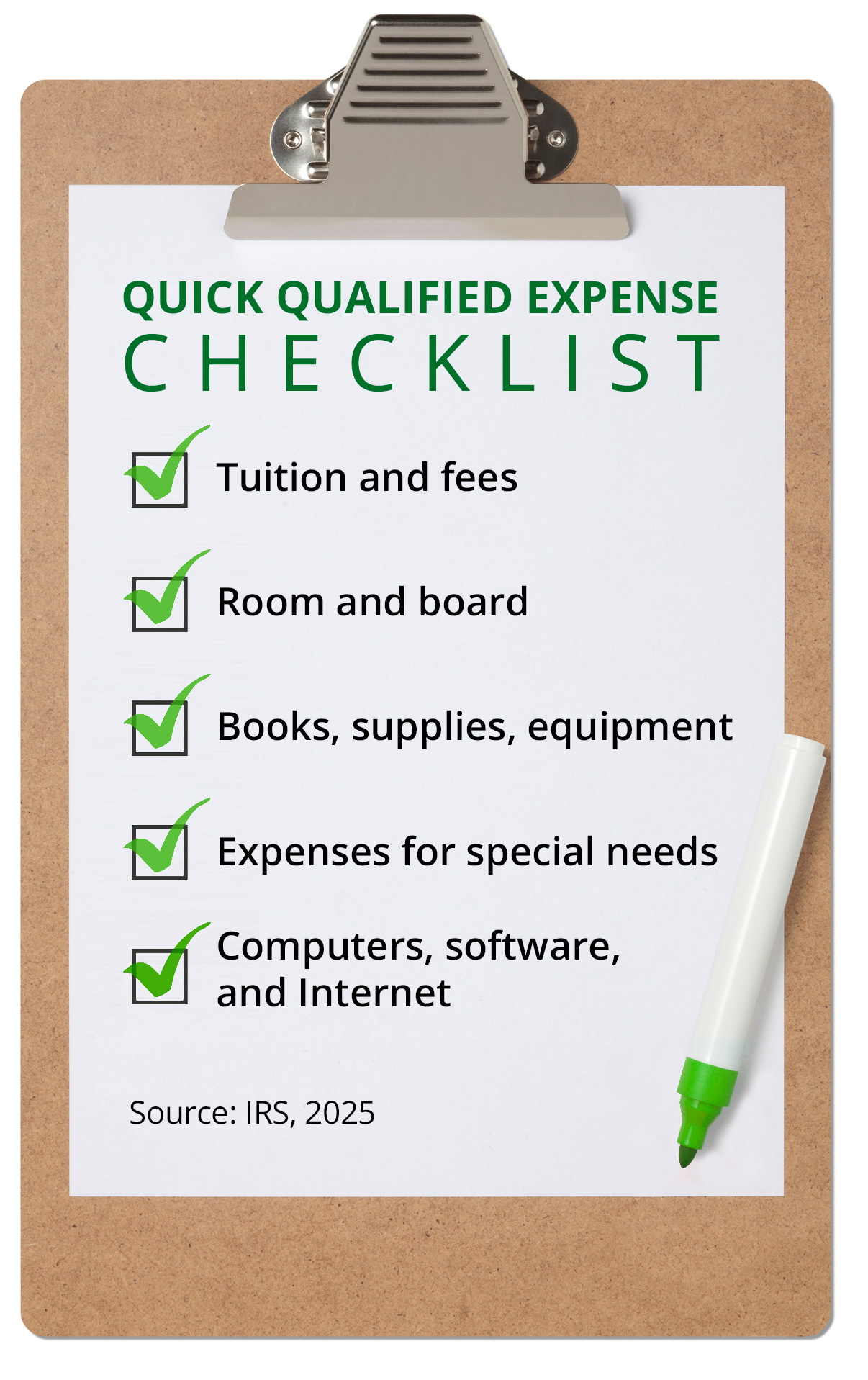
- Take Full Advantage of Tax Benefits
Earnings within your 529 plan grow free from federal taxes. Furthermore, as long as the money withdrawn from your plan is used for qualified expenses at an eligible institution, no federal taxes will need to be paid on these earnings. This is a compelling reason to continue saving through your 529 plan. Non-qualified withdrawals are taxable as ordinary income to the extent of earnings and may also be subject to a 10% federal income tax penalty. Such withdrawals may have state income tax implications. - Save Enough to Cover All Eligible Expenses
While you probably know that your 529 plan savings can be used to pay for college tuition, you may not realize that it can also help pay for other qualified school-related expenses such as fees, books, supplies, computer equipment, and room and board. Some room and board charges are quite high, so you may want to increase your savings rate to cover eligible expenses beyond tuition costs. - Traditional College Expenses Plus More
Your 529 plan dollars can be used for traditional four- and two-year college expenses, accredited vocational and trade schools, as well as graduate and doctoral programs. If your child is thinking about obtaining a graduate or doctoral degree, you may wish to contribute more to your child’s 529 plan. - Expecting? You Can Start Saving Now
If you have another child on the way, consider setting up a 529 plan for this child. You may even set up a new account prior to the child’s birth by listing yourself as the beneficiary, and then changing the beneficiary to your child’s name once he or she is born. Starting early with your 529 college savings plan means that your investments will have more time for potential growth. Investment returns are not guaranteed, and you could lose money by investing in a 529 plan.Taxes on earnings are deferred while they remain in the plan and they can be withdrawn on a tax-free basis as long as they are used for qualified educational expenses. - Protection in Bankruptcy
The United States Bankruptcy Code provides some protection for 529 contributions from creditors in bankruptcy proceedings, subject to certain limitations. Should you file for bankruptcy, your 529 account will be protected if the designated beneficiary is your child, step-child, grandchild or step-grandchild, subject to these limits. Your own state also may have additional creditor protection. For further information, please consult with your legal or tax professional.
- Family and Friends Can Help Save
When family members and friends ask about ideas for birthday presents and holiday gifts for your child, don’t forget to mention your child’s 529 savings plan. Contributing to your child’s college savings plan is a practical, meaningful gift that your child will appreciate into adulthood. - More Than One Plan Can Be Established
A family member or friend may also establish a separate 529 plan for your child. For example, grandparents often opt to do this. As account owners, they can make decisions about the plan’s investments and beneficiaries. Possible estate tax benefits are associated with this option, which may be an attractive consideration. A tax expert should be consulted regarding details on this subject.All accounts for the same beneficiary are added together for purposes of calculating a beneficiary's total account value and to ensure such total account value does not exceed a state's maximum 529 contribution limit. - Convenient Ways to Save
529 offers convenient saving options. You may make a single lump sum investment, send contributions in check form at any time, or save regularly through the 529 Automatic Investment Program. - K-12
Up to $10,000 per student can be withdrawn annually to pay for private or religious K-12 education (increased to $20,000 effective 1/1/2026).**Qualified-expense status varies by state for withdrawals used for K-12 education. Non- qualified withdrawals are taxable as ordinary income to the extent of earnings and may also be subject to a 10% federal income tax penalty. - Apprenticeships and Student Loans
Effective January 1, 2019, as part of the Setting Every Community Up for Retirement Enhancement (SECURE) Act, the benefits of 529 plans were expanded to include some student loan repayments ($10,000 lifetime max per beneficiary) and certain costs associated with apprenticeship programs.*
*Qualified-expense status may vary by state for withdrawals used to repay student loans or to pay for apprenticeship costs. To be considered a qualified 529 plan expense, an apprenticeship program must be registered and certified with the Secretary of Labor under section 1 of the National Apprenticeship Act. Non-qualified withdrawals are taxable as ordinary income to the extent of earnings and may also be subject to a 10% income tax penalty.